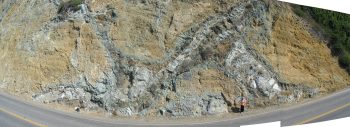Serpetinization and Fluid Interaction of the Cuesta Ridge Ophiolite, California
Kathryn Dianiska

The purpose of this study was to investigate the mode of serpentinization and fluid interaction between serpentinite and rodingite. The serpentinization of ultramafic bodies can occur as a result of fluid flow from meteoric water flowing downwards or from fluids in underthrusted sediments going upwards. Investigation of the petrology and faulting of outcrops of the Cuesta Ridge Ophiolite near Morro Bay, California indicates that serpentinization occurred as top-down metasomatism by meteoric rainwater. The outcrops studied along Highway 41 consist of serpentinite with several rodingititized dikes. There are three different serpentinite lithologic zones distinguished in outcrop by color and increasing distance from contact with the rodingite dike.
Lizardite, the low-temperature, low-pressure serpentine mineral, is the most abundant serpentine mineral, with subsidiary chrysotile mostly found as veins. Carbonate veins are numerous, but quartz veins are absent. The color variation and textural differences seen in thin section and mineralogy differences in X-ray diffraction are the result of hydration and metasomatism. During hydration of olivine, Mg-rich serpentine is formed. Ca is released during the serpentinization of clinopyroxene and is concentrated in the metasomatic fluids. This concentration of calcium then creates the Ca-rich minerals characteristic of rodingite that form when the enriched fluids interact with aluminum found in the diabase. The lithologic zones are controlled by the extent of silica and ferric iron diffusing outwards from the rodingite. The edge of the blue serpentinite marks the outer limit of SiO2 metasomatism. The edge of the blackwall reaction zone marks the extent of Fe3+ hematite veins.
The dikes show evidence for expansion in three dimensions. Thus, serpentinization occurred near the surface with low confining stress. Fault orientations and slicken lineations indicate that faulting separating this part of the ophiolite from the Franciscan rocks is due to Cenozoic strike-slip movement along the Oceanic – West Huasna fault zone. The contact between the ophiolite and the Franciscan is a strike-slip fault zone dipping about 60° to the northeast.
Advisor: Mark Cloos